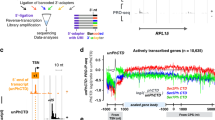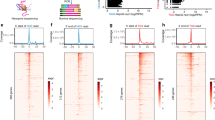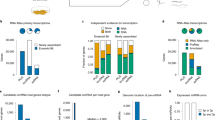Abstract
The transcription cycle of RNA polymerase II (Pol II) correlates with changes to the phosphorylation state of its large subunit C-terminal domain (CTD). We recently developed Native Elongation Transcript sequencing using mammalian cells (mNET-seq), which generates single-nucleotide–resolution genome-wide profiles of nascent RNA and co-transcriptional RNA processing that are associated with different CTD phosphorylation states. Here we provide a detailed protocol for mNET-seq. First, Pol II elongation complexes are isolated with specific phospho-CTD antibodies from chromatin solubilized by micrococcal nuclease digestion. Next, RNA derived from within the Pol II complex is size fractionated and Illumina sequenced. Using mNET-seq, we have previously shown that Pol II pauses at both ends of protein-coding genes but with different CTD phosphorylation patterns, and we have also detected phosphorylation at serine 5 (Ser5-P) CTD-specific splicing intermediates and Pol II accumulation over co-transcriptionally spliced exons. With moderate biochemical and bioinformatic skills, mNET-seq can be completed in ∼6 d, not including sequencing and data analysis.
This is a preview of subscription content, access via your institution
Access options
Subscribe to this journal
Receive 12 print issues and online access
$259.00 per year
only $21.58 per issue
Buy this article
- Purchase on SpringerLink
- Instant access to full article PDF
Prices may be subject to local taxes which are calculated during checkout



Similar content being viewed by others
Accession codes
References
Ozsolak, F. & Milos, P.M. RNA sequencing: advances, challenges and opportunities. Nat. Rev. Genet. 12, 87–98 (2011).
Wilhelm, B.T. & Landry, J.R. RNA-seq-quantitative measurement of expression through massively parallel RNA-sequencing. Methods 48, 249–257 (2009).
Moore, M.J. & Proudfoot, N.J. Pre-mRNA processing reaches back to transcription and ahead to translation. Cell 136, 688–700 (2009).
Morlando, M. et al. Primary microRNA transcripts are processed co-transcriptionally. Nat. Struct. Mol. Biol. 15, 902–909 (2008).
Pawlicki, J.M. & Steitz, J.A. Primary microRNA transcript retention at sites of transcription leads to enhanced microRNA production. J. Cell Biol. 182, 61–76 (2008).
Heidemann, M., Hintermair, C., Voss, K. & Eick, D. Dynamic phosphorylation patterns of RNA polymerase II CTD during transcription. Biochim. Biophys. Acta. 1829, 55–62 (2013).
Core, L.J. & Lis, J.T. Transcription regulation through promoter-proximal pausing of RNA polymerase II. Science 319, 1791–1792 (2008).
Kwak, H., Fuda, N.J., Core, L.J. & Lis, J.T. Precise maps of RNA polymerase reveal how promoters direct initiation and pausing. Science 339, 950–953 (2013).
Weber, C.M., Ramachandran, S. & Henikoff, S. Nucleosomes are context-specific, H2A.Z-modulated barriers to RNA polymerase. Mol. Cell 53, 819–830 (2014).
Mayer, A. et al. Native elongating transcript sequencing reveals human transcriptional activity at nucleotide resolution. Cell 161, 541–554 (2015).
Churchman, L.S. & Weissman, J.S. Nascent transcript sequencing visualizes transcription at nucleotide resolution. Nature 469, 368–373 (2011).
Larson, M.H. et al. A pause sequence enriched at translation start sites drives transcription dynamics in vivo. Science 344, 1042–1047 (2014).
Nojima, T. et al. Mammalian NET-seq reveals genome-wide nascent transcription coupled to RNA processing. Cell 161, 526–540 (2015).
Wuarin, J. & Schibler, U. Physical isolation of nascent RNA chains transcribed by RNA polymerase II: evidence for cotranscriptional splicing. Mol. Cell Biol. 14, 7219–7225 (1994).
Dye, M.J., Gromak, N. & Proudfoot, N.J. Exon tethering in transcription by RNA polymerase II. Mol. Cell 21, 849–859 (2006).
West, S., Proudfoot, N.J. & Dye, M.J. Molecular dissection of mammalian RNA polymerase II transcriptional termination. Mol. Cell 29, 600–610 (2008).
Nojima, T., Dienstbier, M., Murphy, S., Proudfoot, N.J. & Dye, M.J. Definition of RNA polymerase II CoTC terminator elements in the human genome. Cell Rep. 3, 1080–1092 (2013).
Storvall, H., Ramskold, D. & Sandberg, R. Efficient and comprehensive representation of uniqueness for next-generation sequencing by minimum unique length analyses. PLoS ONE 8, e53822 (2013).
Martinez-Rucobo, F.W. et al. Molecular basis of transcription-coupled pre-mRNA capping. Mol. Cell 58, 1079–1089 (2015).
Core, L.J., Waterfall, J.J. & Lis, J.T. Nascent RNA sequencing reveals widespread pausing and divergent initiation at human promoters. Science 322, 1845–1848 (2008).
Min, I.M. et al. Regulating RNA polymerase pausing and transcription elongation in embryonic stem cells. Genes Dev. 25, 742–754 (2011).
Saunders, A., Core, L.J., Sutcliffe, C., Lis, J.T. & Ashe, H.L. Extensive polymerase pausing during Drosophila axis patterning enables high-level and pliable transcription. Genes Dev. 27, 1146–1158 (2013).
Kruesi, W.S., Core, L.J., Waters, C.T., Lis, J.T. & Meyer, B.J. Condensin controls recruitment of RNA polymerase II to achieve nematode X-chromosome dosage compensation. Elife 2, e00808 (2013).
Core, L.J. et al. Analysis of nascent RNA identifies a unified architecture of initiation regions at mammalian promoters and enhancers. Nat. Genet. 46, 1311–1320 (2014).
Acknowledgements
We thank S. Murphy for critically testing this protocol, and A.R. Fialho Grosso for advice on bioinformatics analysis. This work was supported by funding to N.J.P. (Wellcome Trust Programme no. 091805/Z/10/Z and European Research Council (ERC) Advanced grant no. 339270) and to M.C-F. (Fundação Ciência e Tecnologia, Portugal).
Author information
Authors and Affiliations
Contributions
T.N., M.C.-F. and N.J.P. designed the protocol. All authors wrote the paper. T.N. developed the protocol and performed all experiments. T.G. bioinfomatically analyzed the data.
Corresponding authors
Ethics declarations
Competing interests
The authors declare no competing financial interests.
Integrated supplementary information
Supplementary Figure 1 mNET-seq vs GRO-seq
Correlation between log2 (RPM) of Total Pol II mNET-seq and GRO-seq data for genome windows of 500kb. Both samples show very good correlation (Pearson's Correlation Coeficient (PCC) = 0.93, p-value < 2.2e-16). GRO-seq data (GEO accession number GSM1518913) and RNA-seq data used to determine gene expression (GEO accession number GSM1155630) were from previously published studies (Andersson, R. et al. Nat. Commun. 5, 5336 (2014); Lacoste, N. et al. Mol. Cell 53, 631-644 (2014)).
Supplementary Figure 2 mNET-seq Pol II specificity
Boxplot distribution comparison of log2 reads per base (Rpb) values for Total RNA Pol II mNET-seq in expressed protein coding, tRNA and rRNA genes. For protein coding genes, only the region [TSS, TSS+100] is used, to consider a region without reads corresponding to splicing intermediates (which appear at the end of exons), and also to use a region with a size similar to that of tRNA and rRNA genes to avoid any size bias when normalizing.
Supplementary information
Supplementary Text and Figures
Supplementary Figures 1 and 2 (PDF 237 kb)
Rights and permissions
About this article
Cite this article
Nojima, T., Gomes, T., Carmo-Fonseca, M. et al. Mammalian NET-seq analysis defines nascent RNA profiles and associated RNA processing genome-wide. Nat Protoc 11, 413–428 (2016). https://doi.org/10.1038/nprot.2016.012
Published:
Issue Date:
DOI: https://doi.org/10.1038/nprot.2016.012
This article is cited by
-
PRO-IP-seq tracks molecular modifications of engaged Pol II complexes at nucleotide resolution
Nature Communications (2023)
-
Regulation of immunological tolerance by the p53-inhibitor iASPP
Cell Death & Disease (2023)
-
Enhancer–promoter interactions and transcription are largely maintained upon acute loss of CTCF, cohesin, WAPL or YY1
Nature Genetics (2022)
-
Splicing-associated chromatin signatures: a combinatorial and position-dependent role for histone marks in splicing definition
Nature Communications (2021)
-
The pause-initiation limit restricts transcription activation in human cells
Nature Communications (2019)
Comments
By submitting a comment you agree to abide by our Terms and Community Guidelines. If you find something abusive or that does not comply with our terms or guidelines please flag it as inappropriate.



